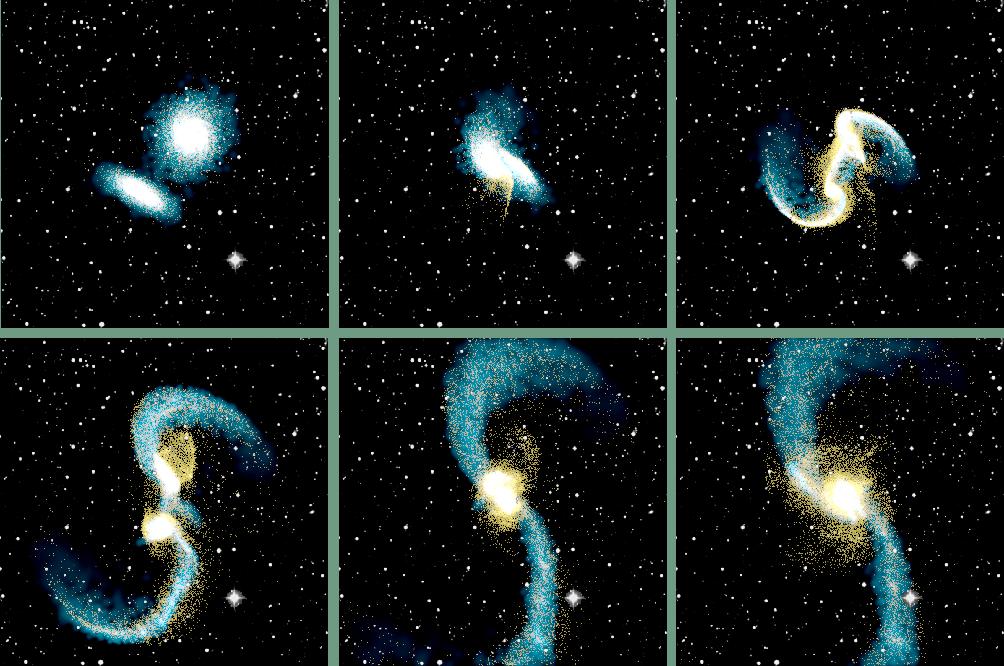today we start turning our minds back to techniques, before we start contemplating what to do about white dwarfs
Stephan tutors us on SPH.
Smooth Particle Hydrodynamics models fluid flow using a Lagrangian method - rather than constructing a grid, as in Eulerian techniques, SPH is not constrained by prior geometry.
Rather SPH samples the fluid flow with particles, which have a compact smoothing kernel to sample overlapping adjacent fluid elements.
The modern implementation of SPH as used in astrophysics goes back to the classic paper of Hernquist and Katz (1988), who combined the relatively newly invented implementation of Lucy (1977) and Gingold and Monaghan (1977) in smoothed partlcle hydrodynamics, with the TREE gravity code introduced by Barnes and Hut (1986), giving computationally efficient implementation of self-gravitating fluid flow without constraining geometries.
SPH is a tremendously powerful code, especially in the TREESPH form and its modern incarnation of GADGET.
Rapid spread of the codes was also aided by it being made available fee to the community, substantial support by the developers to users, good tight code writing and documentation.
Current exploration in method, as opposed to application, includes extensions to full relativistic SPH, implementation of partial and full radiative transfer - the latter is computationally expensive and usually requires either laying down a rigid grid over the simulation or doing poorly matched time explicit ray tracing; and, the problem of implementing magnetohydrodynamics - SPH has fairly pathological problems with enforcing div B = 0 conditions.
Grid codes are superior in capturing and resolving shocks and generally are more accurate in handling viscous terms; MHD is also much more easily done on fixed grids.
SPH is superior for highly heterogenous flows with no fixed geometry and for handling extreme range of densities and spatial scales.
Adaptive mesh codes, which dynamically build, and delete, octal sub-grids, are good compromise codes for some applications, but tend to do best with physical systems with a single heterogeneity - SPH does better handling flows with a range of different contrasts.
All codes run into trouble if Cauchy conditioning is required and time scales get short (ie densities get high).
The sure do make for pretty pictures though...
SPH in action
From TAPS In Bern movie collection


For more SPH prettiness, see Realflow.
http://www.mpa-garching.mpg.de/~volker/arepo/
Springel just presented a new code that uses unstructured grids that looks very promising, combining the benefits of the Lagrangian nature of SPH and the accurate shock-capturing (among other things) of grid based codes.
The model of colliding galaxies is great and I recall seeing photos of actual objects in space (e.g. The Antenna). Does your model give any estimate of the proportion of stars lost to the gravity well? Also, do we only see the stars at the ends of the spiral arms when their density is high enough, or does the model show outliers that would not be visible in nature?
It has been some years since I ran a colliding galaxies model.
The models do predict proportion of stars lost and the evolution of the tidal tails; answer is "it depends" but few percent of stars lost would not be a bad estimate for big galaxies colliding.
The models are quite sensitive to assumptions about the dark matter halo at large radii, and it is slightly worrying that the morphology tends not to be modeled well in detail.
Current state of the art models have mass resolutions of maybe 1000 solar masses, but the spirals mass density contrast is not that high that it biases the simulations.
We can see stellar populations to higher resolution than we can model them, in general.